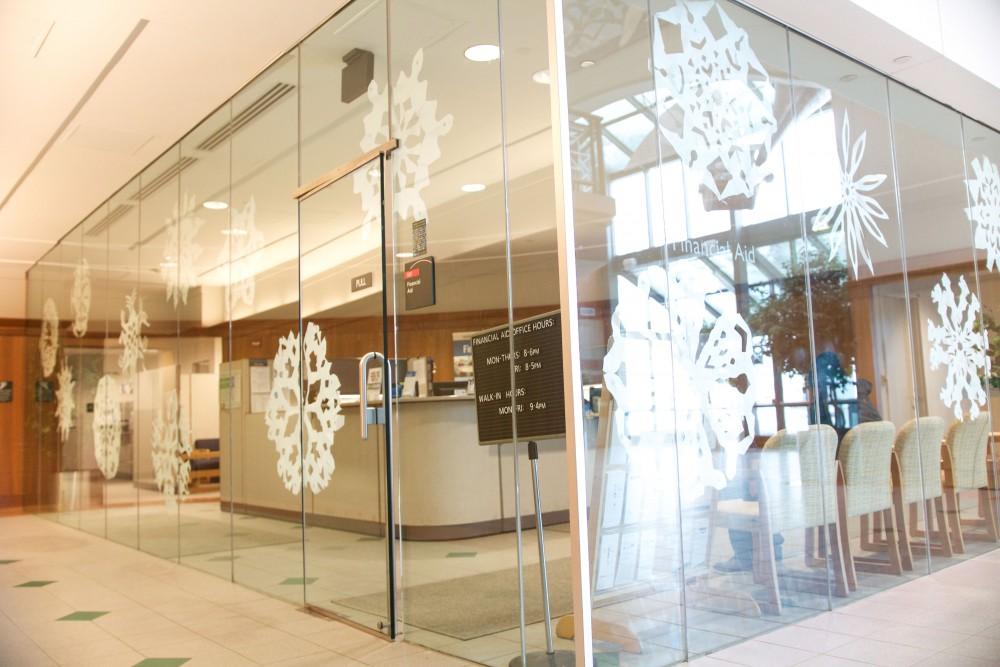Surviving student loans

GVL / Sara Carte The Financial Aid office is located on the first floor of the Student Service building.
Jan 21, 2016
Price of books. GPAs. Midterms and finals. College students face a lot of stress-inducing obstacles during their time in school.
Graduating from school, for many students, seems like a vacation. They won’t have to worry about books, their GPAs, or tests anymore, but just lurking around the corner from graduation is something bigger than most obstacles they faced in school: paying off student loan debt.
According to Grand Valley State University’s financial aid office, the cost of tuition at GVSU is $11,078 a year for lower level credits, and $11,648 a year after 55 credits. Add in $8,360 for room and board, about $700 for books and supplies, and $380 for a parking pass every year and the price tag for finishing a four-year degree is $83,212.
Not many people have an extra $83,000 hanging around. But there are options to get help to pay for college. Students can fill out a FASFA to receive enough financial aid to get through college without having to work too much. The only issue however, all that “free money” isn’t really free.
No matter what happens after college, that $83,000 has to be paid back eventually.
GVSU’s financial aid is helping students to focus on the preventive steps can students can take while still in college to insure they won’t have to worry about paying off loans after graduation.
Lauren McElrath and Luis Lozano, assistant directors of the financial aid office, lead two programs at GVSU called myScholarships and MoneySmart Lakers. These programs are designed to help teach students how to find scholarships, manage the money they have, make a plan beyond school and help reduce the dependency on student loans.
The idea of myScholarships started three years ago when it became apparent signing up for scholarships wasn’t as easy as thought.
“Before myScholarships, students had to go to department by department to try and find scholarships, and a lot of the time they would miss scholarships they were eligible for,” McElrath said. “MyScholarships centralized all the scholarships and made it easier to find ones students qualified for.”
Finding the scholarships wasn’t the only issue students were having.
“The essays we would receive from students applying for scholarships were lacking,” McElrath said. “We saw a need for teaching students how to write effective essays to get the scholarships they needed.”
MyScholarships is holding two drop-in sessions to work alongside students in navigating myScholarships and writing essays for scholarships. The sessions will take place next month on Feb. 3 between 2 p.m. and 4 p.m. and Feb. 11 between 10 a.m. and noon. Both will take place in Room 113 in Henry Hall.
MoneySmart Lakers is another program that started as an idea three years ago and just started happening last year. During its first year, over 230 students met with MoneySmart advisers to start learning how to manage their money better.
“The goal behind MoneySmart is to help prepare students for life after college and refund checks,” Lozano said.
MoneySmart teaches students how to make a spending plan to fit into a college budget, how to build and manage good credit, how to borrow money wisely and how to get proper insurance for the future.
On Feb. 9, the MoneySmart program team will start MoneySmart Academy, a three-week class that helps students get started planning for life after school. The academy will meet every Tuesday and Thursday at 3 p.m.
For more information about myScholarships or the MoneySmart Lakers program, visit www.gvsu.edu/scholarships and www.gvsu.edu/moneysmart.

























